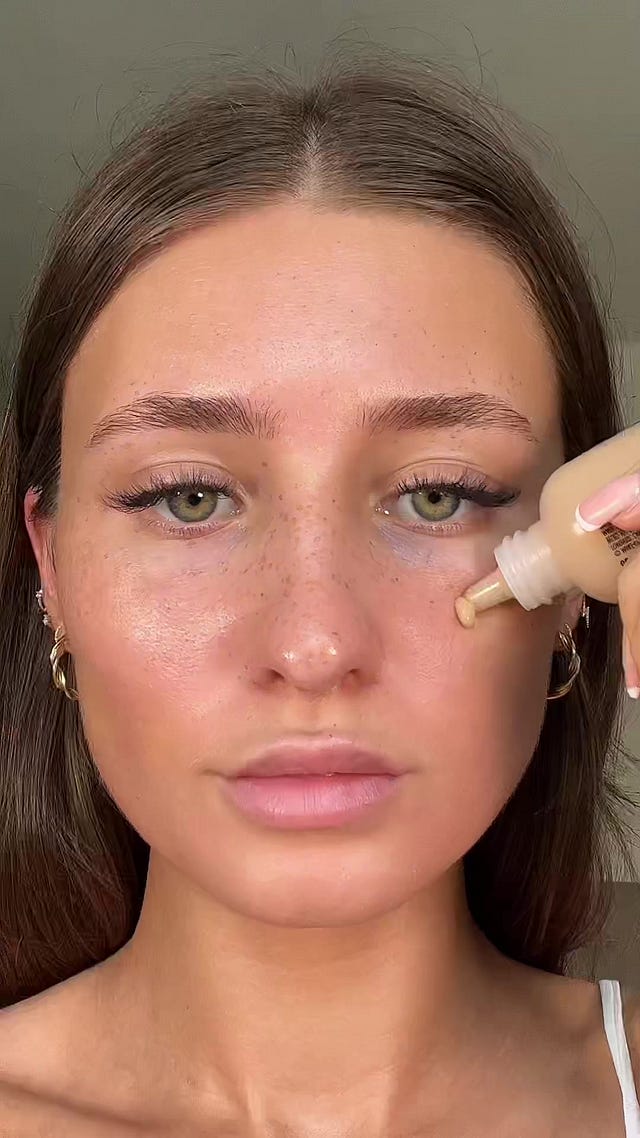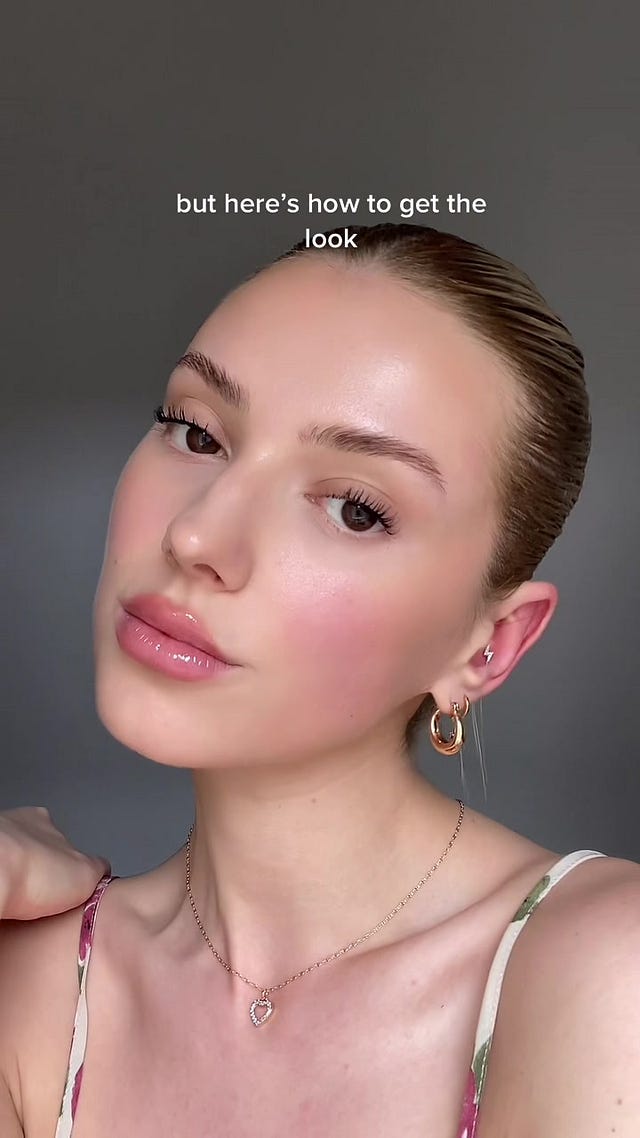A few months ago, I got deep into beauty Tiktok. It started after my daughter was born; I spent many hours holding her with one hand, and the easiest thing to do with the other hand was scroll through Tiktok on my phone. Thus, a Tiktok addiction was born.
While I was already a skincare enthusiast, I was never previously a big makeup person. After watching what probably amounted to hundreds of hours of beauty videos on Tiktok and successfully getting influenced, I decided it was time to buy myself new makeup. I had all but stopped wearing makeup since the pandemic began in 2020 and we began working from home, so all of my purchased-before-the-pandemic items were now well over two years old and long expired. (It was also right around the time of the annual Sephora sale, which gave me a perfect excuse to go wild and buy a whole bunch of new things.)
While I certainly wasn’t about to start wearing makeup every day again — I was still on maternity leave, after all, so it really was not necessary — I did start putting on makeup basically any time I left my house to see people above the age of three months. And when I started to do my new makeup routine, it actually felt… fun! Maybe it was because I felt like garbage during most of my pregnancy, maybe because I hadn’t worn makeup for most of the last two years, but suddenly, putting makeup felt exciting and made me feel like a new woman, one who was no longer too exhausted to do anything. I felt like a real person in the world again.
If you haven’t lost hours of your life to BeautyTok like I have, a makeup trend that’s currently very popular on the platform is the “Clean Girl” look, a no-makeup makeup look that actually takes a lot of makeup to pull off. Glowing, flawless skin, blushing cheeks, glossy lips, perfect brows.
I admit that I totally fell for this, as someone who previously loved skincare but didn’t care much about makeup. I had gotten into skincare a few years ago, and bought into the idea that perfecting your skin was more important than makeup. I started doing an elaborate multi-step skincare routine every day with a range of serums and essences and acids and oils and masks in hopes of making my dry skin as hydrated and “glowy” as possible. The Clean Girl aesthetic that was suddenly all over Tiktok felt like the natural extension of my obsession with skincare. (And though it has only recently become popular on Tiktok, it’s not really a new idea — the no-makeup makeup look has been around for years.)
 Tiktok failed to load.
Tiktok failed to load.Enable 3rd party cookies or use another browser
I’ve had a difficult time reconciling my new makeup habit, however, with the underlying reality of the beauty and skincare industrial complex and the standards it perpetuates.
There’s something insidious about the idea that the best makeup look is one that communicates effortlessness and ease, even while it actually takes quite a bit of effort — effort that must be hidden. Additionally, for many people, having “good” skin is actually a function of wealth, often attained not through eye masks and hyaluronic acid serums but through Botox, plastic surgery, and other cosmetic procedures, all of which are on the rise.
The Clean Girl aesthetic feels like it is about signaling a certain class status. The Tiktokers pushing the Clean Girl look are overwhelmingly white and skinny. The “clean” makeup products they push are also quite expensive. (Every video has the exact same Kosas concealer and Ilia Skin tint and Rare Beauty blush and Charlotte Tillbury contour wand and Dior Lip Oil.) The Clean Girl look is perceived as more tasteful than wearing heavier makeup, makeup that might reveal to people that you’re actually trying.
As a person who until relatively recently was still only buying drugstore makeup, I found myself wondering how a 22-year-old can afford a daily routine that consists of $42 foundation and dozens of other products ranging from $20-$50 each. (It took years before I felt comfortable enough financially to treat myself to a Nars Orgasm blush, the first thing I ever bought from Sephora.) Turns out, it takes quite a bit of money to look like you’re “naturally” beautiful.
I recently started reading the very good newsletter The Unpublishable, where reporter Jessica DeFino takes a critical look at the beauty industry. DeFino recently examined the underlying message of the Clean Girl aesthetic:
Minimal makeup, then, is maximal everything else. It’s more masquerading as less. Framing the trend as a “five-minute makeover” or “two-minute makeup” or simply “clean” allows customers of a certain class — the beauty bourgeoisie — to reap the rewards of cosmetic labor without the gauche appearance of having performed said labor.
Critically examining the way society pushes unfair and unrealistic beauty standards on women makes it a lot harder to enjoy skincare as “self-care.” It’s harder to enjoy indulging in sheet masks and squalane when you remember that you’re doing it because society has told us women have to look younger and have perfect skin.
Can we still have fun with makeup even while knowingly perpetuating society’s beauty standards for women? Can we enjoy skincare and beauty while still taking a critical eye to the industry that profits off of our collective endless need to look younger, dewier, more perfect?
I don’t have any great answers here. I subscribe to the belief that two things can be true at once. I don’t think I’ll be quitting my skincare routine or my makeup habits anytime soon. (In the process of writing this piece, I subscribed to three beauty podcasts and two new beauty newsletters, so if anything, I’ve only fallen further down the rabbit hole.) I still think a skincare routine can still feel replenishing; at minimum, it’s a few minutes a day that I spend on myself, and that feels nice. But I also give myself permission to skip the skincare routine if it ever feels like a chore, or skip the makeup if it feels like something I need to do in order to leave the house. We shouldn’t let these rituals become something we feel like we have to do, because we’ve been made to feel like our “regular” skin isn’t fit to be seen by other people.
Good things to read
Scenes from an open marriage, The Paris Review.
The dinner party is now very online, Eater.
How rosé became a lifestyle, New York Times.
The history of the Tripp Trapp chair, which changed the children’s design game, Dwell.
Restriction as possibility, lifestyle as politics, Mold Magazine.
Eleven Madison Park wanted to go vegan. Then it all went wrong, Bon Appetit.
Cities aren’t built for kids, The Atlantic.
Nathan Fielder is out of his mind (and inside yours), Vulture.
The complicated life of the abortion pill, The New Yorker.
The older woman comes of age, The Atlantic.
Eric Adams, the mayor who never sleeps, New York Times.
Good things to cook
Things I’ve made recently: An excellent kale salad. Thai chicken flatbread pizza. Buffalo chicken zucchini boats. My favorite corn salad for summer BBQs.





guys i know you may be needing skin care and alot of make up products but just to let you know is that it dosn't matter if your in your 50 or 60 and you hate like absoulutly hate getting wrenckly skin it does not matter!! you'r butiful just the way you are and believe you are.
Loved reading this, especially as I used the pandemic to get more into skincare, and ironically, makeup. A big part of this was finally having more time in the mornings than when I had to dash out the door though the irony wasn't lost on me that I was seeing far fewer people. I'll recommend another Substack I appreciate, former beauty editor (for O magazine) Valerie Monroe's adroitly named, "How to Not F*** Up Your Face." I love her frankness about (not) spending money on products, aging, and examining how the beauty industry has conned women into illusions about beauty, on many levels. Thank you for this dive into this topic! https://valeriemonroe.substack.com/